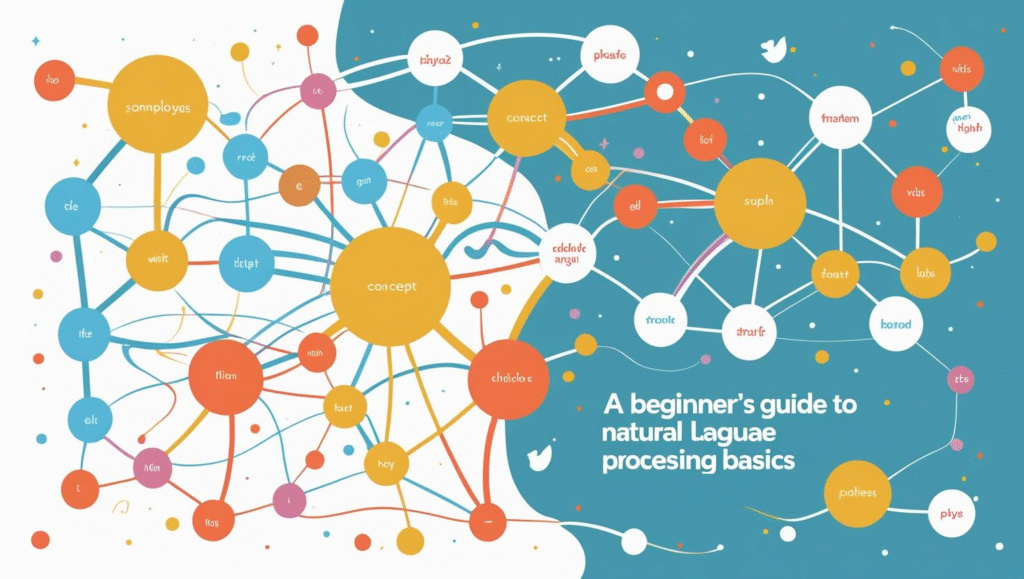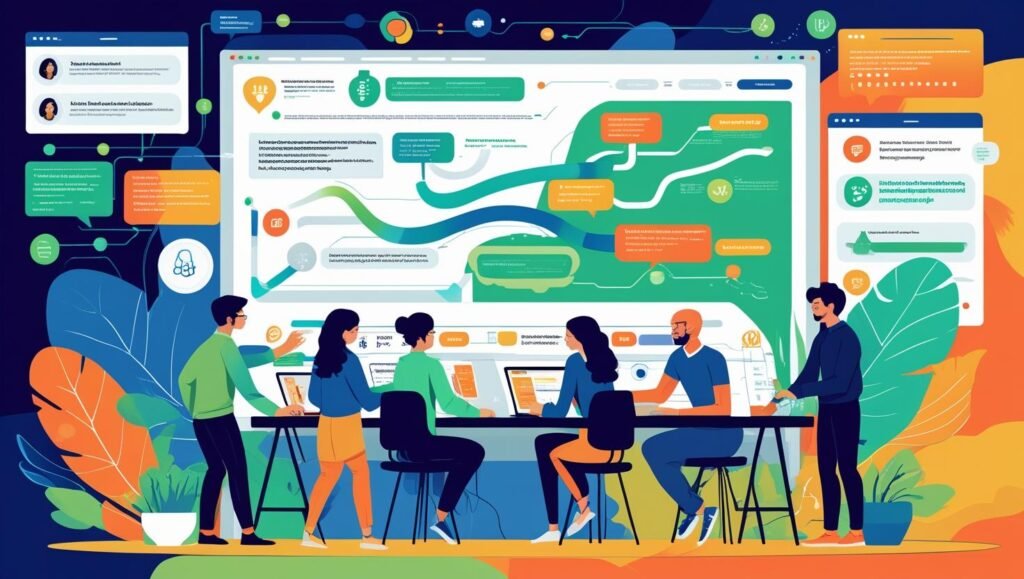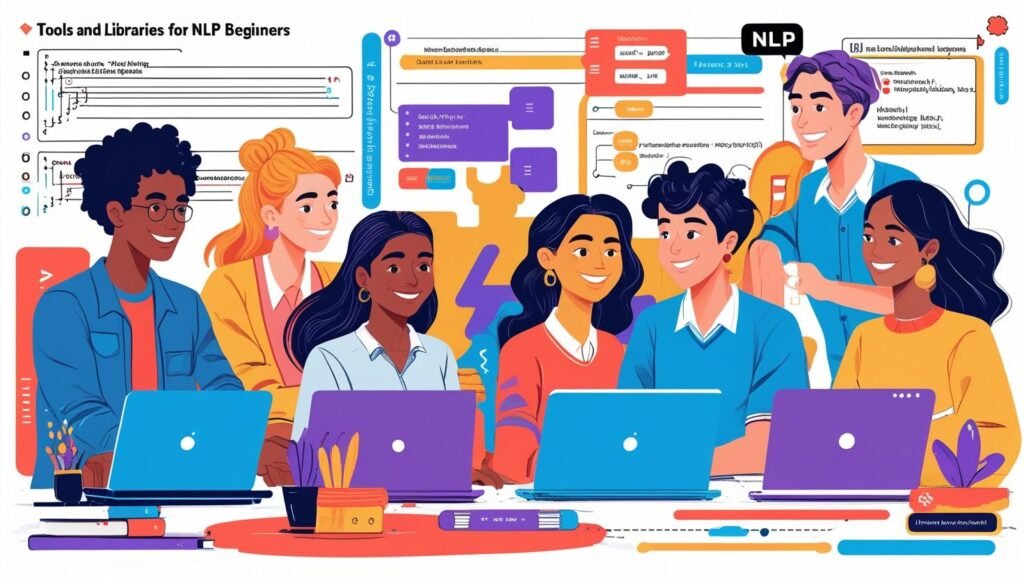A Beginner’s Guide to Natural Language Processing Basics

Have you ever wondered how digital assistants understand your voice commands or how chatbots seem to know exactly what you need? Welcome to the fascinating world of Natural Language Processing (NLP)! As a pivotal branch of artificial intelligence, NLP bridges the gap between human communication and computer understanding, enabling machines to interpret, generate, and respond to language just like us.
Whether you’re interested in improving customer interactions or simply curious about the technology shaping our daily lives, mastering the basics of NLP is an essential skill in today’s digital landscape. This beginner’s guide will demystify the complexities of NLP, introducing you to key concepts, terms, and applications.
Dive in and discover how language transforms from mere text into meaningful insights and interactions, and unlock the potential of this powerful technology!
The Importance of NLP in Today’s Digital World
In our increasingly digital world, Natural Language Processing (NLP) has emerged as a transformative technology, holding the key to seamless human-computer interaction. NLP allows computers to understand, interpret, and generate human language, making it possible for machines to communicate with us in a way that feels natural and intuitive. This capability is crucial as it bridges the gap between human communication and digital systems, enabling a myriad of applications from voice-activated assistants to sophisticated data analysis tools. As businesses and individuals rely more on digital communication, the importance of NLP continues to grow, fostering more efficient and effective interactions.
The role of NLP in enhancing customer service is particularly noteworthy. Chatbots and virtual assistants powered by NLP can handle customer queries around the clock, providing instant responses and freeing up human agents for more complex issues. This not only improves customer satisfaction but also reduces operational costs for businesses. Moreover, NLP-driven sentiment analysis tools can gauge customer emotions and feedback from social media, reviews, and surveys, offering valuable insights into customer behavior and preferences. By leveraging these insights, companies can tailor their products, services, and marketing strategies to better meet customer needs.
Beyond customer service, NLP is revolutionizing various industries by unlocking the potential of unstructured data. In healthcare, for instance, NLP is used to analyze clinical notes and medical literature, aiding in disease diagnosis and treatment planning. In the legal field, NLP helps in sifting through vast amounts of legal documents to find relevant information, thereby expediting the research process. The educational sector benefits from NLP through automated grading systems and personalized learning experiences. As more sectors recognize the benefits of NLP, its adoption is expected to soar, driving innovation and efficiency across the board.
Key Concepts and Terminology in NLP

To truly understand NLP, it’s essential to familiarize oneself with some key concepts and terminology that form the foundation of this field. One of the most fundamental concepts in NLP is the distinction between syntax and semantics. Syntax refers to the structure of language, including grammar and sentence formation rules, while semantics deals with the meaning conveyed by the words and sentences. A robust NLP system must comprehend both aspects to accurately interpret and generate human language.
Another critical concept is tokenization, the process of breaking down text into smaller units, such as words or phrases, known as tokens. Tokenization is a preliminary step in many NLP tasks, as it allows the system to analyze and manipulate individual components of the text. Alongside tokenization, part-of-speech (POS) tagging is an important technique where each token is labeled with its corresponding part of speech, such as noun, verb, or adjective. POS tagging helps in understanding the syntactic structure of sentences, which is crucial for various NLP applications like parsing and information extraction.
Named Entity Recognition (NER) is another significant term in the NLP lexicon. NER involves identifying and classifying entities mentioned in the text into predefined categories, such as names of people, organizations, locations, dates, and more. This technique is widely used in information retrieval, question answering systems, and text summarization. Additionally, understanding the concept of sentiment analysis is vital. Sentiment analysis aims to determine the sentiment or emotion expressed in a text, whether positive, negative, or neutral. This is especially useful in analyzing customer feedback, social media posts, and reviews to gauge public opinion and sentiment trends.
How Natural Language Processing Works: A Brief Overview of Techniques
NLP employs a variety of techniques to process and understand human language, ranging from traditional rule-based approaches to advanced machine learning models. At the core of NLP is the process of text preprocessing, which involves cleaning and preparing the text for analysis. Common preprocessing steps include removing stop words (common words like “a,” “an,” and “the” that add little meaning), stemming (reducing words to their base or root form), and lemmatization (converting words to their canonical form). These steps help in standardizing the text and reducing noise, making it easier for NLP algorithms to analyze.
One of the foundational techniques in NLP is n-grams, which are contiguous sequences of n items (words or characters) from a given text. N-grams are used to capture the context and relationships between words, aiding in tasks such as text prediction and language modeling. For example, bigrams (2-grams) and trigrams (3-grams) are commonly used to understand word pairs and triplets, respectively. These models can predict the next word in a sequence based on the previous words, enhancing the fluency and coherence of generated text.
Machine learning has significantly advanced the capabilities of NLP, with supervised learning being a predominant approach. In supervised learning, algorithms are trained on labeled datasets, where the input text is paired with the correct output or label. Common algorithms used in NLP include decision trees, support vector machines (SVM), and neural networks. Neural networks, particularly deep learning models like Recurrent Neural Networks (RNN) and Transformer models, have revolutionized NLP in recent years. RNNs are designed to handle sequential data, making them suitable for tasks like language translation and sentiment analysis. Transformer models, such as Google’s BERT and OpenAI’s GPT, leverage attention mechanisms to process text in parallel, enabling them to understand context and generate human-like text with remarkable accuracy.
Common Applications of Natural Language Processing

The versatility of NLP is evident in its wide range of applications, each leveraging the technology’s ability to understand and generate human language. One of the most prevalent applications is in the development of virtual assistants like Apple’s Siri, Amazon’s Alexa, and Google Assistant. These assistants use NLP to comprehend voice commands, provide relevant responses, and perform tasks such as setting reminders, playing music, and controlling smart home devices. By continuously learning from user interactions, these assistants become more adept at understanding and anticipating user needs, enhancing the overall user experience.
Another significant application of NLP is in the realm of text analytics and sentiment analysis. Businesses use NLP to analyze customer reviews, social media posts, and survey responses to gauge public opinion and sentiment towards their products and services. This analysis provides valuable insights into customer preferences, pain points, and emerging trends, enabling companies to make data-driven decisions and improve their offerings. Additionally, NLP-powered sentiment analysis can help monitor brand reputation and detect potential crises early, allowing businesses to address issues proactively.
NLP is also transforming the field of content creation and summarization. Automated content generation tools use NLP to produce articles, reports, and even creative writing pieces based on specified parameters. These tools save time and effort for content creators, while maintaining a consistent style and tone. On the other hand, text summarization tools condense lengthy documents into concise summaries, highlighting the key points and essential information. This is particularly useful for professionals who need to stay updated with vast amounts of information but have limited time to read through comprehensive reports and articles.
Challenges and Limitations of NLP
Despite its remarkable advancements, NLP still faces several challenges and limitations that researchers and developers must address. One of the primary challenges is the inherent ambiguity and variability of human language. Words and phrases can have multiple meanings depending on the context, and the same concept can be expressed in numerous ways. This variability makes it difficult for NLP systems to consistently interpret and generate accurate responses. Homonyms, idiomatic expressions, and cultural nuances further complicate the task, requiring sophisticated models that can understand and adapt to different contexts.
Another significant limitation is the bias present in training data and algorithms. NLP models are often trained on large datasets sourced from the internet, which can contain biased or prejudiced language. These biases can inadvertently be learned by the models, leading to discriminatory or unfair outcomes in applications such as hiring, lending, and law enforcement. Addressing bias in NLP requires careful curation of training data, development of fairness-aware algorithms, and continuous monitoring to ensure equitable and unbiased performance.
Moreover, the computational complexity and resource requirements of advanced NLP models pose a challenge. State-of-the-art models like BERT and GPT-3 require substantial computational power and memory for training and inference, making them inaccessible for many organizations and individuals. Additionally, these models often need vast amounts of labeled data for training, which can be expensive and time-consuming to obtain. Researchers are actively exploring ways to create more efficient models and leverage transfer learning and unsupervised learning techniques to reduce the dependence on large datasets.
Tools and Libraries for NLP Beginners

For those new to NLP, a variety of tools and libraries are available to simplify the learning process and facilitate the development of NLP applications. One of the most popular libraries is the Natural Language Toolkit (NLTK) for Python. NLTK provides a comprehensive suite of tools for text processing, including tokenization, POS tagging, parsing, and more. It also includes a collection of corpora and lexical resources, making it an excellent starting point for beginners. The extensive documentation and tutorials available for NLTK further ease the learning curve.
Another widely-used library is spaCy, known for its speed and efficiency. SpaCy offers pre-trained models for various NLP tasks such as named entity recognition, dependency parsing, and text classification. Its user-friendly API and seamless integration with other libraries like TensorFlow and PyTorch make it a favorite among both beginners and experienced practitioners. Additionally, spaCy’s support for multiple languages and its ability to handle large volumes of text efficiently make it a versatile tool for diverse NLP projects.
For those interested in deep learning-based NLP, the Hugging Face Transformers library is an invaluable resource. This library provides access to a plethora of pre-trained transformer models, including BERT, GPT-3, and RoBERTa, which can be fine-tuned for specific tasks with minimal effort. The library’s intuitive interface and extensive documentation make it accessible for beginners, while its advanced features cater to the needs of seasoned developers. Furthermore, Hugging Face’s collaborative community and ongoing updates ensure that users have access to the latest advancements in NLP.
Getting Started with Your First NLP Project
Embarking on your first NLP project can be an exciting and rewarding experience. To begin, it’s essential to choose a project that aligns with your interests and skill level. For beginners, simple projects like text classification, sentiment analysis, or keyword extraction are ideal starting points. These projects provide a solid foundation in fundamental NLP concepts and techniques without overwhelming complexity. Once you’ve selected a project, the next step is to gather and preprocess your data. Depending on the project, you may need to collect text data from various sources such as web scraping, APIs, or publicly available datasets.
After obtaining the data, the preprocessing phase involves cleaning and preparing the text for analysis. This includes tasks like removing punctuation, converting text to lowercase, tokenization, and stemming or lemmatization. Preprocessing is crucial as it ensures that the data is in a consistent format, making it easier for NLP models to analyze. With the data ready, you can proceed to select and implement the appropriate NLP techniques and algorithms for your project. For instance, if you’re working on sentiment analysis, you might use a machine learning classifier like logistic regression or a deep learning model like an LSTM (Long Short-Term Memory) network.
Finally, it’s time to evaluate and fine-tune your model. Evaluation metrics such as accuracy, precision, recall, and F1-score will help you assess the performance of your model and identify areas for improvement. Fine-tuning involves adjusting hyperparameters, experimenting with different algorithms, and incorporating additional features to enhance the model’s accuracy and robustness. Throughout the process, it’s essential to document your progress and findings, as this will help you reflect on your learning and share your insights with the broader NLP community. By following these steps, you’ll gain hands-on experience and build a strong foundation in NLP.
The Future of Natural Language Processing

The field of Natural Language Processing is continuously evolving, with new trends and advancements emerging at a rapid pace. One of the most exciting trends is the development of more sophisticated and capable language models. Models like GPT-3 have demonstrated remarkable abilities in understanding and generating human-like text, and future iterations are expected to push the boundaries even further. These advancements will enable more natural and fluent interactions between humans and machines, opening up new possibilities for applications such as conversational agents, automated content creation, and personalized learning experiences.
Another significant trend is the integration of multimodal learning in NLP, which involves combining text with other data modalities such as images, audio, and videos. Multimodal models can understand and generate content that encompasses multiple forms of data, leading to more comprehensive and contextually aware applications. For example, a multimodal model could analyze a video along with its transcript to provide more accurate content summaries or generate descriptive captions for images. This trend is expected to enhance the capabilities of NLP systems, making them more versatile and applicable to a wider range of tasks.
Ethical considerations and fairness in NLP are also gaining prominence as the technology becomes more pervasive. Researchers and developers are increasingly focusing on addressing biases in NLP models and ensuring that they perform equitably across different demographic groups. This involves developing techniques for bias detection and mitigation, creating more diverse and representative training datasets, and establishing guidelines for ethical AI practices. As awareness of these issues grows, the NLP community is likely to prioritize fairness and accountability, leading to more responsible and inclusive applications of the technology.
Conclusion :
Natural Language Processing is a fascinating and rapidly advancing field that holds immense potential for transforming the way we interact with technology. By understanding the basics of NLP, including its key concepts, techniques, applications, and challenges, you can begin to appreciate the intricacies of this powerful technology. Whether you’re looking to improve customer service, analyze vast amounts of text data, or simply explore the capabilities of AI, mastering NLP is an invaluable skill in today’s digital landscape.
For those eager to delve deeper into NLP, numerous resources are available to aid your learning journey. Online courses and tutorials from platforms like Coursera, edX, and Udacity offer structured learning paths and hands-on projects to build your expertise. Books such as “Speech and Language Processing” by Daniel Jurafsky and James H. Martin and “Natural Language Processing with Python” by Steven Bird, Ewan Klein, and Edward Loper provide comprehensive insights into the theory and practice of NLP. Additionally, joining NLP communities and forums, such as the NLP subreddit or the Hugging Face community, can help you stay updated with the latest developments and connect with fellow enthusiasts.
As you continue to explore and experiment with NLP, remember that the field is constantly evolving, presenting new challenges and opportunities. Stay curious, keep learning, and don’t hesitate to seek out new resources and collaborations. By doing so, you’ll be well-equipped to harness the full potential of NLP and contribute to its ongoing advancement. Happy learning!
For the latest insights and updates, be sure to explore our AI Trends & News and stay ahead in the world of artificial intelligence.

Pingback: Whisper AI Voice: Everything you need to know! - AI insights world
Pingback: AI in Personalized Marketing - AI insights world
Pingback: ChatGPT and Perplexity: Which AI is Truly Smarter? - AI insights world
Pingback: What Is Minimax AI? China’s Answer to OpenAI Explained - AI insights world
Pingback: Grok 3 Chat Overview - AI insights world